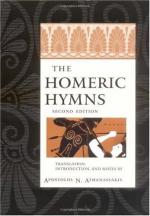{82} Recherches sur l’Origine et la Nature des Mysteres d’Eleusis. Klinikseck. Paris, 1895.
{84} Herodotus, ii. 171.
{85a} Spencer and Gillen, “Natives of Central Australia,” p. 399. The myth is not very quotable.
{85b} Foucart, p. 19, quoting Philosophoumena, v. 7. M. Foucart, of course, did not know the Arunta parallel.
{85c} Journal Anthrop. Inst. (1884), pp. 194, 195, “Ngarego and Wolgal Tribes of New South Wales.”
{85d} Ibid. (1885), p. 313.
{86a} For ample information on this head see Mr. Clodd’s “Tom-Tit-Tot,” and my “Custom and Myth” ("Cupid, Psyche, and the Sun Frog").
{86b} Panegyr., 28.
{87a} Clem. Alex. Protrept., ii. 77 et seq.
{87b} Harpocration, s. v. [Greek text].
{87c} Cf. [Greek text]. Hippon, 90, and Theophrastus, Charact. 6, and Synesius, 213, c. Liddell and Scott, s.v. [Greek text].
{88a} “Sand and Spinifex,” 1899.
{88b} Foucart, pp. 45, 46
{88c} Hymn, Orph., 41, 5-9.
{89a} Heriot, 1586.
{89b} Foucart, pp. 56-59.
{90} Foucart, p. 64.
{91a} Basil Thomson, “The Kalou-Vu” (Journal Anthrop. Inst., May 1895, pp. 349-356). Mr. Thomson was struck by the Greek analogies, but he did not know, or does not allude to, Plutarch and the Golden Scroll.
{91b} Fragments, V. p. 9, Didot; Foucart, p. 56, note.
{95a} Herodotus, Alilat, i. 131, iii. 8.
{95b} “Cities and Bishoprics of Phrygia,” 1895, vol. i. pp. 91, 92.
{104} Callim., H. Apoll. 30.
[Greek verse]
{115} The Greek is corrupt, especially in line 213.
{121} This action was practised by the Zulus in divination, and, curiously, by a Highlander of the last century, appealing to the dead Lovat not to see him wronged.
{124} A folk-etymology from [Greek text] = to rot.
{127} A similar portent is of recent belief in Maori tradition.
{133} See Essay on this Hymn.
{136} In our illustration both the lyre with a tortoise shell for sounding-board, and the cithara, with no such sounding-board, are represented. Is it possible that “the tuneful shell” was primarily used without chords, as an instrument for drumming upon? The drum, variously made, is the primitive musical instrument, and it is doubted whether any stringed instrument existed among native American races. But drawings in ancient Aztec MSS. (as Mr. Morse has recently observed) show the musician using a kind of drum made of a tortoise-shell, and some students have (probably with too much fancy) recognised a figure with a tortoise-shell fitted with chords, in Aztec MSS. It is possible enough that the early Greeks used the shell as a sort of drum, before some inventor (Hermes, in the Hymn) added chords and developed a stringed instrument. Cf. p. 39.




